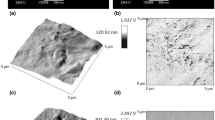Abstract
This study investigated the effect of surface wettability, hardness and surface contact on the germination and subsequent development of Botryosphaeriaceae species conidia. Mean percent germination for isolates Neofusicoccum luteum MM558, N. luteum CC445, N. parvum G652 and Botryosphaeria dothidea 007 was highest on cellulose which was the most hydrophilic surface (72.2%, 76.9%, 52.4% and 74.9%, respectively), but did not differ between the other surfaces tested (glass, polystyrene and Parafilm M™). Germ tube growth for all isolates was least on cellulose and similar on the other surfaces. Cellulose agar assays indicated that mycelia could be utilising the cellulose as a food source. Germination assays on surfaces of different hardness showed no discernible patterns of germination or growth related to hardness. Further, there was no effect on germination of surface contact versus continuous shaking of conidial suspensions for isolate N. luteum MM558. These assays demonstrated that conidia of the Botryosphaeriaceae were able to germinate on a variety of surfaces with this flexibility indicative of their reported pathogenicity of different host tissues.


Similar content being viewed by others
References
Adebayo, A. A., & Harris, R. F. (1971). Fungal growth responses to osmotic as compared to matric water potential. Proceedings Soil Science Society of America, 35, 465–469.
Amiri, A., Cholodowski, D., & Bompeix, G. (2005). Adhesion and germination of waterborne and airborne conidia of Penicillium expansum to apple and inert surfaces. Physiological and Molecular Plant Pathology, 67(1), 40–48.
Amponsah, N. T., Jones, E. E., Ridgway, H. J., & Jaspers, M. V. (2009). Rainwater dispersal of Botryosphaeria conidia from infected grapevines. New Zealand Plant Protection, 62, 228–233.
Amponsah, N. T., Jones, E. E., Ridgway, H. J., & Jaspers, M. V. (2012a). Microscopy of some interactions between Botryosphaeriaceae species and grapevine tissues. Australasian Plant Pathology, 41(6), 665–673.
Amponsah, N. T., Jones, E. E., Ridgway, H. J., & Jaspers, M. V. (2012b). Susceptibility of grapevine tissues to Neofusicoccum luteum conidial infection. Plant Pathology, 61(4), 719–729.
Apoga, D., Jansson, H.-B., & Tunlid, A. (2001). Adhesion of conidia and germlings of the plant pathogenic fungus Bipolaris sorokiniana to solid surfaces. Mycological Research, 105(10), 1251–1260.
Baskarathevan, J. (2011). Botryosphaeriaceous infection in New Zealand vineyards: Identification population structure and genetic diversity. PhD Thesis: Lincoln University, Lincoln, New Zealand.
Carver, T. L. W., & Ingerson, S. M. (1987). Responses of Erysiphe graminis germlings to contact with artificial and host surfaces. Physiological and Molecular Plant Pathology, 30, 359–372.
Chaky, J., Anderson, K., Moss, M., & Vaillancourt, L. (2001). Surface hydrophobicity and surface rigidity induce spore germination in Colletotrichum graminicola. Phytopathology, 91(6), 558–564.
Doehlemann, G., Berndt, P., & Hahn, M. (2006). Different signalling pathways involving a Gαprotein, cAMP and a MAP kinase control germination of Botrytis cinerea conidia. Molecular Microbiology, 59(3), 821–835.
Egley, G. H. (1994). Substrate surface influences upon germination of Colletotrichum truncatum conidia. Canadian Journal of Botany, 72(12), 1758–1765.
Espinoza, J. G., Briceño, E. X., Chávez, E. R., Úrbez-Torres, J. R., & Latorre, B. A. (2009). Neofusicoccum spp. associated with stem canker and dieback of blueberry in Chile. Plant Disease, 93(11), 1187–1194.
Guest, D., & Brown, J. (1997). Infection processes. In J. F. Brown & H. J. Ogle (Eds.), Plant pathogens and plant diseases (pp. 245–262). Armidale: Rockvale Publications.
Ilmén, M., Saloheimo, A., Onnela, M. L., & Penttilä, M. E. (1997). Regulation of cellulase gene expression in the filamentous fungus Trichoderma reesei. Applied and Environmental Microbiology, 63(4), 1298–1306.
Jelitto, T. C., Page, H. A., & Read, N. D. (1994). Role of external signals in regulating the pre-penetration phase of infection by the rice blast fungus Magnaporthe grisea. Planta, 194(4), 471–477.
Jo, W.-S., Bae, S.-H., Cho, D.-H., Park, S.-D., Yoo, Y.-B., & Park, S.-C. (2009). Optimal medium conditions for the detection of cellulolytic activity in Ganoderma lucidum. Mycobiology, 37(4), 313–316.
Jones, E. E., Stewart, A., & Whipps, J. M. (2011). Water potential affects Coniothyrium minitans growth, germination and parasitism of Sclerotinia sclerotiorum sclerotia. Fungal Biology, 115(9), 871–881.
Kasana, R. C., Salwan, R., Dhar, H., Dutt, S., & Gulati, A. (2008). A rapid and easy method for the detection of microbial cellulases on agar plates using Gram’s iodine. Current Microbiology, 57(5), 503–507.
Kunoh, H., Yamaoka, N., Yoshioka, H., & Nicholson, R. L. (1988). Preparation of the infection court by Erysiphe graminis: I. Contact-mediated changes in morphology of the conidium surface. Experimental Mycology, 12(4), 325–335.
Kuo, K., & Hoch, H. C. (1996). Germination of Phyllosticta ampelicida pycnidiospores: Prerequisite of adhesion to the substratum and the relationship of substratum wettability. Fungal Genetics and Biology, 20(1), 18–29.
Li, M., Gao, Z., Hui, M., Zhou, S., Yang, D., Yang, B., Yi, J., & Yang, F. (2012). Pathogenicity of cell wall degrading enzymes produced by Botryodiplodia theobromae pat. Against mangoes. Agricultural Biotechnology, 1(6), 18–21.
Magan, N., & Lynch, J. M. (1986). Water potential, growth and cellulolysis of fungi involved in decomposition of cereal residues. Journal of General Microbiology, 132(5), 1181–1187.
Meguro, A., Fujita, K., Kunoh, H., Carver, T. W., & Nicholson, R. (2001). Release of the extracellular matrix from conidia of Blumeria graminis in relation to germination. Mycoscience, 42(2), 201–209.
Nadeau, M. P., Dunphy, G. B., & Boisvert, J. L. (1995). Effects of physical factors on the development of secondary conidia of Erynia conica (Zygomycetes: Entomophthorales), a pathogen of adult black flies (Diptera: Simuliidae). Experimental Mycology, 19, 324–329.
Nesci, A., Etcheverry, M., & Magan, N. (2004). Osmotic and matric potential effects on growth, sugar alcohol and sugar accumulation by Aspergillus section Flavi strains from Argentina. Journal of Applied Microbiology, 96(5), 965–972.
Ritz, K., & Young, I. M. (2004). Interactions between soil structure and fungi. Mycologist, 18(02), 52–59.
Sammonds, J., Jaspers, M. V., & Jones, E. E. (2016). Pre-infection processes of Botryosphaeriaceae spp. conidia: Adhesion to different substrata. Plant Pathology, 65, 1142–1152.
Shafi, A., Ridgway, H. J., Jaspers, M. V., & Jones, E. E. (2017). Conidial production by Botryosphaeriaceae species from grapevine shoot lesions in Marlborough vineyards. New Zealand Plant Protection, 70, 295–300.
Shafi, A., Ridgway, H. J., Jaspers, M. V., & Jones, E. E. (2019). Variability and influence of temperature and relative humidity on sporulation of Neofusicoccum species on grapevine shoots. European Journal of Plant Pathology In press.
Shahriarinour, M., Mohd Noor, A. W., Ariff, A., & Mohamad, R. (2011). Screening, isolation and selection of cellulolytic fungi from oil palm empty fruit bunch fibre. Biotechnology, 10(1), 108–113.
Shaw, B. D., Carroll, G. C., & Hoch, H. C. (2006). Generality of the prerequisite of conidium attachment to a hydrophobic substratum as a signal for germination among Phyllosticta species. Mycologia, 98(2), 186–194.
Slippers, B., & Wingfield, M. J. (2007). Botryosphaeriaceae as endophytes and latent pathogens of woody plants: Diversity, ecology and impact. Fungal Biology Reviews, 21(2–3), 90–106.
Staples, R. C., & Hoch, H. C. (1997). Physical and chemical cues for spore germination and appressorium formation by fungal pathogens. In G. C. Carroll & P. Tudzynski (Eds.), Plant Relationships (pp. 27–40), The Mycota (A Comprehensive Treatise on Fungi as Experimental Systems for Basic and Applied Research) (Vol. 5). Berlin: Springer.
Takikawa, Y., Xu, L., Kakutani, K., Nonomura, T., Sameshima, T., Matsuda, Y., & Toyoda, H. (2011). Conidia of the tomato powdery mildew Oidium neolycopersici initiate germ tubes at a predetermined site. Mycoscience, 52(3), 198–203.
ten Have, A., Tenberge, K., Benen, J.A.E., Tudzynski, P., Visser, J., & van Kan, J.A.L. (2002). The contribution of cell wall degrading enzymes to pathogenesis of fungal plant pathogens. In Agricultural Applications (11 ed., pp. 341–358): Springer Berlin Heidelberg. Retrieved from https://doi.org/10.1007/978-3-662-03059-2_17.
Tucker, S. L., & Talbot, N. J. (2001). Surface attachment and pre-penetration stage development by plant pathogenic fungi. Annual Review of Phytopathology, 39(1), 385–417.
Úrbez-Torres, J. R. (2011). The status of Botryosphaeriaceae species infecting grapevines (Vol. 50, pp. S5–S45). Phytopathologica Mediterranea.
Úrbez-Torres, J. R., & Gubler, W. D. (2011). Susceptibility of grapevine pruning wounds to infection by Lasiodiplodia theobromae and Neofusicoccum parvum. Plant Pathology, 60(2), 261–270.
Úrbez-Torres, J. R., Battany, M., Bettiga, L. J., Gispert, C., McGourty, G., Roncoroni, J., & Gubler, W. D. (2010). Botryosphaeriaceae species spore-trapping studies in California vineyards. Plant Disease, 94(6), 717–724.
van Niekerk, J. M., Calitz, F., Halleen, F., & Fourie, P. H. (2010). Temporal spore dispersal patterns of grapevine trunk pathogens in South Africa. European Journal of Plant Pathology, 127(3), 375–390.
Warwar, V., & Dickman, M. B. (1996). Effects of calcium and calmodulin on spore germination and appressorium development in Colletotrichum trifolii. Applied and Environmental Microbiology, 62(1), 74–79.
Wright, A. J., Carver, T. L. W., Thomas, B. J., Fenwick, N. I. D., Kunoh, H., & Nicholson, R. L. (2000). The rapid and accurate determination of germ tube emergence site by Blumeria graminis conidia. Physiological and Molecular Plant Pathology, 57(6), 281–301.
Wunderlich, N., Ash, G. J., Steel, C. C., Raman, H., & Savocchia, S. (2011). Association of Botryosphaeriaceae grapevine trunk disease fungi with the reproductive structures of Vitis vinifera. Vitis, 50(2), 89–96.
Acknowledgements
The authors would like to thank Lincoln University for funding this research.
Funding
Funding was provided by Lincoln University.
Author information
Authors and Affiliations
Corresponding author
Ethics declarations
Conflict of interest
None of the authors declare a conflict of interest, with all authors consenting to publication.
Ethical approval
This article does not contain any studies with human participants or animals performed by any of the authors.
Rights and permissions
About this article
Cite this article
Sammonds, J., Jaspers, M.V. & Jones, E.E. Influence of surface characteristics on germination and early growth of Botryosphaeriaceae species. Eur J Plant Pathol 154, 1125–1134 (2019). https://doi.org/10.1007/s10658-019-01733-y
Accepted:
Published:
Issue Date:
DOI: https://doi.org/10.1007/s10658-019-01733-y




